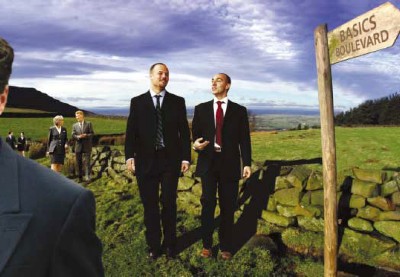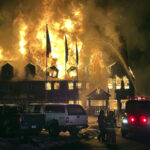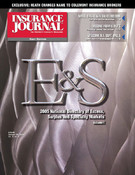E&S Industry Returns to Familiar Ground
Neither wind, nor rain nor the dark cloud of standard carriers returning to the marketplace will keep excess and surplus insurance writers from maintaining profitability. From coast-to-coast the E&S industry is going back to the basics and returning to familiar ground while also trying to pioneer in new areas, as more and more standard companies jump back into the marketplace they fled just a short time ago.
Memories fade fast in the East
Short-term memory hinders the E&S market on the East coast some say.

The catastrophic events of Sept. 11 are barely three years old, but the threat of terrorism is apparently a distant memory to the policyholders along the Eastern seaboard. Despite ongoing debate over the need for an extension of the government-sponsored Terrorism Risk Insurance Act (TRIA), which is scheduled to expire at the end of 2005, underwriters and producers in excess and surplus have seen a dramatic drop in the number of business owners and property owners who seek out financial protection from acts of terrorism. Insurers have apparently lost interest in the coverage, too.
“If TRIA expires, carriers will have been forced to write prorated policies to cover their interests of policyholders in the event of another terrorist strike in America,” explained Steve Donovan, president of Crump of New York, an insurance wholesaler specializing in property and workplace coverage.
From Donovan’s viewpoint in Manhattan, insurance companies and policyholders have both lost interest in the necessity for terrorism insurance.
“Terrorism insurance–like most surplus coverage–is reactive,” Donovan said. “E&S providers need to be proactive in order to keep an edge on the market and stay one step ahead of the standard carriers.”
Susan Harris of Burns & Wilcox in New Jersey said her clients look at terrorism insurance as a “necessary evil.” She explained that the need for protection from risk declines with clients in relation to their physical distance from Ground Zero. She estimated that less than 10 percent of potential clients even inquire about the availability of terrorism insurance.
As in other sections of the country, E&S producers along the East coast have been forced to return to many of the traditional risk categories or seek out new markets in an effort to maintain the high levels of premium and profitability the surplus market has sustained since 9/11.
“We’ve lost some nice D&O business to standard carriers trying to buy back portions of the market abandoned in the past few years,” said Jim Griffith of Princeton Risk Managers. “The standard market carriers can smell when an account has money. This is not a soft market, but we’ll walk away from a competitive situation that is not worth our time or effort.”
Griffith said the umbrella market has not maintained the price level he would have expected from a hard market. His office has focused on the more traditional surplus lines of medical professionals, general contractors and miscellaneous liability for 2005.
The Baltimore office of Burns & Wilcox is searching for new niche markets to drive its bottom line in the new year, according to Richard Trippe, branch manger.
“Show me a left-hander screwdriver manufacturer and I’ll show you a good E&S risk,” Trippe said.
E&S carriers keep ‘tradition’ in Midwest states
E&S producers in the Midwestern states are also experiencing competition from traditional insurance carriers that have re-emerged with hopes of capturing lost market share and prosperity.
“The earth don’t shake and the wind don’t blow here like other parts of the country,” Brian Richie, the branch manager for Burns & Wilcox in Cleveland, said with a smile. “E&S carriers in this area have a more traditional view of classes of business rather than reacting to changes. But that can all change very quickly.”
The Ohio marketplace is significantly softer than other regions of the country, in the viewpoint of Richie. He said he saw evidence of standard carriers re-entering the market up to two years ago.
Eileen Concannon in St. Louis agrees the re-entry began sometime ago. “We have seen standard carriers creeping in for the past 18 months,” said Concannon, the executive vice president of Michael F. Concannon Inc. in St. Louis. “This happens every few years. Standard carriers see the profitability and the glamour and want a taste. But when they get a real taste, most (standard insurance companies) will realize this market is not for them and they disappear again.”
Christopher Gaddis of Donald Gaddis Co. Inc. in Chicago explained that being a relatively smaller player allows his company to plan for short-term dips in the market without having a long term impact on the company or its employees. Donald Gaddis Co. Inc. generates an average of $300 million in E&S premium every year.
“We hit $1 million [in profit] for the first time in 2004, but we’ve been careful not to let the increased revenues during the hard market influence us to ratchet up our fixed expenses,” Gaddis said. “We expect to see a 10 percent decline in volume in 2005. It will take a commendable effort on my office’s part to keep it from being worse.
“One of the luxuries of being small and privately held is that you can plan realistically around the volatile E&S marketplace.”
Gaddis said that Illinois is becoming less of a buyer’s market, while the gap appears to be narrowing between rates in the Midwest and many of the large industrial states.
Stronghold in coastal Southeast states
Political winds, as well as the memory of four major hurricanes in 2004, were apparently not strong enough to keep competitors away from Florida and the Southeast.
Despite almost $20 billion in insured losses from 2.2 million claims from the hurricanes that battered Florida, the property casualty insurance industry marked its first profitable year in a quarter century.
“It’s almost as if this industry cannot stand prosperity,” said Bob Lane, branch manager of the Burns & Wilcox office in Charlotte, N.C. “Greed is the only explanation why the standard carriers have come back into areas we have not seen them since before 9/11. The industry broke even after dividends last year, and may actually post a profit this year for the first time since 1978.”
Lane said the re-emergence of standard carriers has forced providers of E&S coverage to get back into traditional lines of distressed business. He said surplus carriers must seek out more than just commercial accounts with red ink, or with exposure to catastrophic risk.
Even with the return of standard carriers, the coastal regions from the Carolinas to Texas remain the exclusive territory of surplus carriers. The fight for business begins beyond the high-tide line.
Louisiana’s sluggish economy is having a direct impact on the insurance industry. Renewal rates in coastal areas have seen an increase during the fourth quarter of the year, while rates for other commercial risks are being judged on a parish-by-parish basis.
The inland competition has forced a softening of prices in areas with many markets, including the newest companies and industries moving into the state. Professional liability, as well as E&O, have become major portions of business being written by producers in the surplus market in Louisiana and other states in the Southeast.
Innovation is the key in Southwest states
With the significant exception of exposures to wind and rain, surplus line insurance companies in the Southwest have begun an all-out search for emerging markets.
Many of the common surplus risks elsewhere in the country–such as vacant buildings and depressed industries–are non-existent in most parts of the Southwest where many cities are not old enough to have developed depressed areas in their downtown core. The commercial side of the business thrives on attractive office and industrial buildings built in out-of-the way locations with poor access to fire protection.
That leaves underwriters and carriers on the prowl for new industries and emerging technologies to maintain premium.
“The fringe market has become the standard market,” said Michael Maharaj, branch manager for Burns & Wilcox in Scottsdale, Ariz. “The first person in the door usually wins the business. It takes a knowledge of the risks and knowing the marketplace to survive when others see a soft market.”
“An agent (in the Southwest) cannot survive by writing vacant buildings like so many do in areas like Detroit or Cleveland,” Maharaj said. “Show me a software producer or a manufacturer of parts for an Apache helicopter. E&S can feast on leftover portions of coverage that standard carriers will not write.
“Agents must get creative and innovative,” Maharaj added. “Knowledge of the market is essential to get in with the new companies who create their own new risks.”
Todd Telitell, president of Heath Insurance Brokers of Texas, now known as Colemont Insurance Brokers (see article on page N4), added that E&S producers must become more aggressive in their pursuit of new niche risks to maintain the lifeblood of the surplus industry.
“We have seen (standard) carriers across all lines with a broadening appetite for the bottom line profitability we have enjoyed since 9/11,” Telitell said. “We are still writing business and renewals with many of the clients who came to us after 9/11. But many (of these clients) are either negotiating or asking for terms.”
The rates for wind driven business and treaty renewals have remained stable, with some slight increases in some select cases, according to Telitell.
“Standard carriers are never far away if there is perceived profitability and the losses are kept to an acceptable level,” Telitell said. “E&S must widen its base. That has always been the heart and soul of the surplus industry. Innovation will keep the wolves away from our door.” Telitell added that agents too must “broaden their vision.”
West ropes in booming E&S industry
The catastrophic hurricanes in the Southeast have apparently had little impact on the urgency for supplemental disaster insurance for policyholders in the West. The emergence of standard carriers in traditional E&S strongholds has only served to inspire surplus market players in the West to maintain their advantage with innovation.
“The surplus market is catastrophe driven,” explained Mike Stutsman of Worldwide Facilities Inc. in Seattle. “Sure, we have seen more retailers sniffing around our back door. But the surplus industry is at the apex of this cycle of the hard market. I am not getting five calls every day begging for coverage like we did in the glory days, but the sky is not falling just because of a little competition.”
Stutsman said he expects to see a lot more competition before prices begin to fall in the Northwest. The fact that capacity has not increased for the past 12 to 18 months lets Stutsman sleep well at night. He said many contractors–and other high-risk commercial accounts–have taken a more comprehensive look at risk management in an effort to stabilize rates.
Rudy Whitcomb, president of Whitcomb Surplus Lines Brokers Inc. in southern California sees a need to expand his firm’s landscape. He plans to expand his book of commercial lines as well as contact former clients in residential construction to keep up the levels of premium and profit he has posted since 2000.
“There may be a boom in construction because of the hurricanes in Florida,” Whitcomb said. “But nowhere is expanding as quickly as California. The amounts of legislation here require builders to have adequate amounts of coverage before they can begin the smallest project. People who want a piece of the construction pie in California will pay any price for adequate insurance. I’m banking on that.”
As for new markets in the construction industry, Whitcomb said contractors are seeking out more and more product liability.
The market for commercial contractors remains hard in California, according to the branch managers of the Burns & Wilcox offices in Fresno and San Francisco.
Corporate D&O renewals have remained steady, but most of the new agreements have required a degree of negotiation, according to Burns & Wilcox Branch Manager Ceil Norton in Fresno. In the Bay Area, earthquake coverage remains a high priority.
“Sure, we have lost some business to standard carriers,” said Burns & Wilcox Vice President Harvey Goldenberg. “But California is such a large player in the surplus market that we will more than make up from the few losses in areas without competition from the standard carriers, including residential contractors and professional liability in the for-profit and non-profit sectors.”
Reduced capacity at Lloyd’s
The announcement that Lloyd’s of London would be cutting its capacity by 9 percent in 2005 concerned W. Harold Petersen of Petersen International Underwriters. The reduction in capacity, in Petersen’s opinion, could be seen as a boost to the competitive spirit of surplus providers, but he was wary of the ability to underwrite new markets with enough reserve to deal with the urgent needs of a catastrophic event.
“There may be sufficient capacity. I certainly hope so,” Petersen said, “because 2004 was a glorious year and we are looking forward to another.”
Wendy Baker, the president of Lloyd’s of America, did not hide the fact that the reduction in capacity was a decision designed to inspire agents and brokers to submit a higher quality business. Lloyd’s ultimate goal is more black ink to the bottom line.
“(The competition) is a sign that the market is beginning to soften,” Baker said, “but this is nothing new. It’s the type of thing we have seen in the past at this stage of the (insurance sales) cycle.”
Baker said the decision by Lloyd’s to reduce capacity came only after extensive discussions with its American representatives.
Topics Catastrophe California Carriers Agencies Florida Profit Loss Excess Surplus Hurricane Market Construction Lloyd's Contractors
Was this article valuable?
Here are more articles you may enjoy.


 Baldwin Group to Buy CAC Group for About $1B in Cash and Stock
Baldwin Group to Buy CAC Group for About $1B in Cash and Stock  Acrisure to Buy MGA Vave From Canopius
Acrisure to Buy MGA Vave From Canopius  Owner of Historic Minnesota Resort Charged With Arson, Insurance Fraud
Owner of Historic Minnesota Resort Charged With Arson, Insurance Fraud  Pierce Named CEO of GEICO as Combs Resigns
Pierce Named CEO of GEICO as Combs Resigns 


